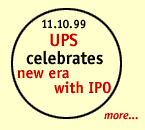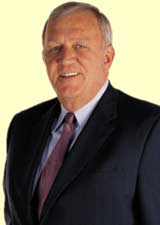|
|
|
||||
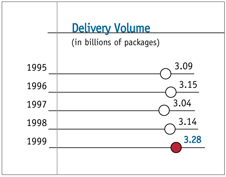 |
March 15, 2000 To our shareowners, |
|||
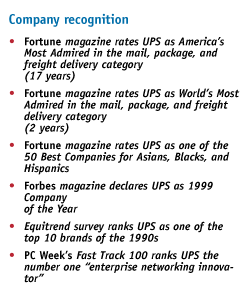 |
As a public enterprise, UPS will leverage our financial strength to expand our international business and pursue new opportunities in the movement of goods, information, and funds. These opportunities come with the promise of complementing and growing our core package delivery business. I should also point out that today’s changing environment is nothing new to UPS. Transformation and reinvention are a way of life for us. Since our humble beginnings in a small basement office in Seattle, UPS has refined the art of changing to keep ahead of new market realities, new competitors, new technologies, and new models for conducting business and enabling commerce. There are certain timeless values and philosophies that define our culture at UPS. Indeed, I believe the extraordinary dedication of our people, and the strong commitments we make to our customers, shareowners, and communities are the primary reasons we have been able to grow our business for nearly a century. Our people and our values are also why we are now poised to enable our customers’ move into a new frontier of commerce as we begin the next century. At the same time, our company will perpetuate the values of broad-based employee ownership. |
|||
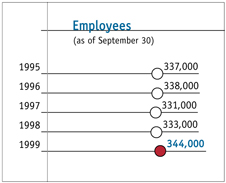 |
Our company took a bold step toward that frontier with a strong financial showing in 1999. By all key measures, 1999 was a successful year for UPS. We experienced solid volume growth, especially in our international express services. We continued to manage our operations well in terms of service and cost, and we took aggressive steps in expanding our presence in the growing arenas of e-commerce, logistics management, and financial services. UPS reports results across three business segments – U.S.-domestic package operations, international package operations, and non-package operations. Revenue growth in 1999 for each of these segments increased over the previous year. Total revenue in 1999 grew 9.1 percent, to just over $27 billion. Our operating profit grew 29.1 percent, to $3.99 billion. Net income was $883 million, down from the previous year due to a second quarter charge against earnings of $1.44 billion, the result of an adverse Tax Court decision. In 1999, UPS delivered an average of 12.9 million packages a day to over 200 countries and territories, up 4.6 percent over 1998. In the United States, we experienced solid growth across all product categories. Our continued success in logistics and e-commerce solutions contributed significantly to these results along with a strong holiday season where we were again the leading carrier of goods purchased over the Internet. On the busiest day of the holiday season, our worldwide volume climbed to 18.7 million packages. Through our flexible and sound logistics network, we were able to help a number of customers cope with unexpected surges in demand, particularly those who rely heavily on Web-based orders. UPS’s international operations also continued to surge ahead with the rapid globalization of the marketplace. Our export products experienced double-digit volume growth in 1999 and helped fuel international operating profit, which grew to over $250 million, compared to $56 million the previous year. Clearly, our international business is gaining momentum. Today, it accounts for $3.7 billion in revenue, or about 14 percent of UPS’s total revenue. Non-package operations experienced significant improvement and financial gains. Revenue for this segment was over $1 billion and operating profit improved to $168 million. These are encouraging numbers for an area of the business that offers great growth opportunity, even though continued expansion will result in necessary start-up costs. In just the past few years, profound changes have taken place in customer behavior. The end customer now enjoys the opportunity to become more informed and is better able to research and direct suppliers, and to ultimately have a strong voice in the functioning of the supply chain. It’s a win-win model in which companies carry less inventory and have less capital outlay. Products get to customers faster, cash flow is maximized, and customer satisfaction increases. UPS is positioned to take advantage of all these trends. Business-to-business e-commerce sales, in particular, have exploded from almost zero a few years ago to more than $100 billion today, according to a study by Deloitte Consulting. Deloitte also projects that 91 percent of U.S. businesses will do their purchasing over the Internet by the end of 2001, a threefold increase from today. This new dynamic commerce model is one that is driven by the combined forces of globalization, e-commerce, and integrated supply chains. It is further defined by speed, pressure to contain costs, and near-perfect service. Through it all, UPS customers are leveraging the power of electronic connectivity. Managing information about a package along the entire supply chain is crucial in today’s environment. We’ve taken several steps to make that information a productive tool for customers, including investing more than $11 billion in information technology over the past 15 years. Innovative sorting and scanning technologies now allow UPS to capture detailed information – electronically – on about 75 percent of the packages flowing through our system each day. We expect that to increase to 90 percent by the end of the coming year. Today, through a range of diversified businesses such as UPS Logistics Group, UPS Capital, UPS Service Parts Logistics, and UPS e-Ventures, we are able to offer our customers solutions at any point along the supply chain. Before I close, I want to recognize an individual who had a major impact on our company. John Alden, our former vice chairman, recently concluded a 35-year career with UPS. That tenure included serving on the Management Committee for the past 14 years. During his career, John was responsible for overseeing marketing, sales, advertising, public relations, and strategic planning. John was also instrumental in the development and growth of the UPS Logistics Group. Perhaps John will be best known as one of the main champions of the UPS brand, having introduced the first national advertising campaign to UPS nearly 20 years ago and then overseeing a host of innovative advertising and promotional initiatives, including UPS’s sponsorship of the Olympic Games. We wish John and his family the best in retirement. Our integrated products, combined with our vast worldwide infrastructure, unmatched technology, and financial strength, create a dynamic formula for future growth. The demonstrated commitment of UPS people to meet our service, revenue, and cost goals, while they adhere to our principles of integrity, trust, and teamwork, will be what sets our company apart. These attributes will sustain and strengthen UPS’s role as we enable global commerce for our customers.
|
|||
| Special note regarding forward-looking statements. © 2000 United Parcel Service of America, Inc. |








